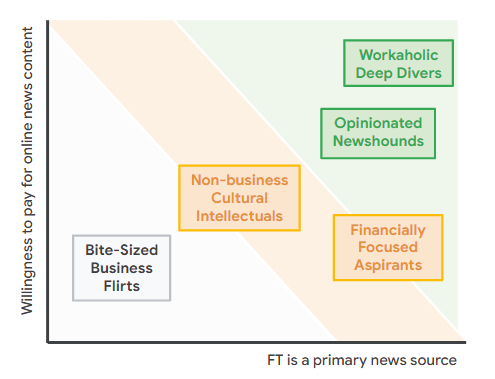Against the backdrop of fierce competition for audience attention where rising content supply meets flat content demand, organisations in the media space have been actively trying to calibrate their content strategies to stand out from the pack. Whilst this has been no easy task, the lessons learnt from an industry where publishing lies at the core of business operations can be relevant for any content-generating entity.
Players in the Financial Services industry are no exception - in fact, they share a high number of tangency points with media publishers when it comes to content production and content consumption. Here are some areas and use cases where financial institutions can benefit from publishing houses’ experience in content strategy design:
- B2B: buy-side and sell-side investment research
- B2C: wealth management, retail banking and private banking
- B2B & B2C: marketing, white paper publishing and social media communications
Building a differentiated content strategy: 5 key actions for financial institutions
FT Strategies, drawing upon FT’s content management expertise and digital transformation journey, has helped over 200 organisations with differentiating their content strategy. In the process, we have identified 5 key actions that financial institutions should focus on:
1. Measuring content engagement
Many organisations still assess content performance using quantity-based metrics such as open rates or click-through rates. These are fine but limit an organisation’s ability to understand underlying trends between consumption of their product (content) and critical business metrics like acquisition and retention. Realising the need to use quality-linked measures of content consumption, the FT built its own engagement metrics: RFV (‘Recency, Frequency and Volume’) and ‘Quality Reads’. These allow the FT to better gauge the value of its content and continuously adapt its strategy - both metrics have been found to be correlated with customer lifetime value (LTV) and retention.
The FT uses the RFV score to group users into engagement clusters to deploy relevant customer success tactics based on their level of engagement.
‘Quality Reads’ is a metric that measures consumption depth on a per-article basis. It is based on content length, average reading speed and time spent.
Whether it is advanced ways to measure engagement or simple volume-based metrics, FT Strategies can help establish critical values through an examination of content consumption patterns and their impact on the business at large.
2. Embedding user centricity
Historically, many financial institutions have been more product-focused than customer-centric in the way they have planned and produced content.
At the FT, we know that adopting a more user-centric approach to content strategy can open avenues for more effective monetisation. We find two elements to be key to enabling customer centricity: Feedback Gathering and Personas.
Feedback Gathering Loop
Setting up a continuous customer feedback loop that draws upon multiple feedback sources is an enabler for embedding customer centricity in content production. That being said, external benchmarking studies on content consumption are still the main source of insight for content planners in financial institutions. To bolster customer centricity, The FT collects feedback from its users on a regular basis through a number of proactive and reactive methods: including onsite surveys, NPS tracking, customer interviews and B2B client interactions.
Synthesising a coherent picture from multiple feedback sources can be challenging unless a systematic approach is applied. To address that, FT Strategies creates a composite score which manages the information coming from different parts of the feedback loop. It is useful for creating a unified view that can be tracked over time and is understood by different departments in the organisation.
Personas
The FT also uses personas at the core of its segmentation and content planning.
Leveraging first-party and second-party data on user behaviour and demographics, the FT continuously iterates its user profiling to ensure its content strategy stays relevant:





3. Streamlining storylining and content discovery
A closer look at what readers consume and why they consume it reveals many organisations often produce too much of the wrong type of content. Prioritising the right content types and ensuring customers receive the right content recommendations is key.
Meeting “user needs”
Identifying consumption patterns according to content type, and adapting the ‘mix’ of produced content accordingly, are pillar components of an effective content strategy. As summarised in a recent blog by FT Strategies’ Senior Consultant Aliya Itzkowitz, a retroactive study of articles published over a 2 month period allowed a UK media outlet to find out it needed to calibrate its content strategy, as it was over-indexing towards articles types that were not as popular:
Recommendations & meta-tagging
Placement, recommendations and content tagging are key to ensuring customers find what they are looking for and have a seamless and personalised user experience. The FT has ample experience with those - adopting hybrid meta-tagging in 2019 has led to an increase in search, direct and social media traffic.
4. Leveraging alternative content formats and distribution channels
With the rise of mobile and data visualisation tools, digital content has evolved into being much more than simply non-interactive text consumed on a big screen. That being said, a number of publishing teams in financial institutions still use PDF as their main delivery format and, like media players, will go through a content digitization journey of their own.
FT has adapted to meet changing realities by utilising alternative content formats and new distribution channels:
Alternative content formats
Infographics, podcasts, videos and webinars already underpin the core of FT’s content strategy, especially as they appear more salient to certain target demographic groups. Simply offering those in a tick-box exercise is not enough - having a strategy on how to manage them is key to ensuring those serve to boost user engagement.
Distribution channels
Newsletters, push notifications and social media sharing have become potent tools in driving content engagement for the FT. In fact, internal experiments at the FT have shown that tweaking those in the right format can lead to a double-digit % growth in content consumption. With the emergence of ecosystems in Financial Services, particularly around retail banking and wealth management, the importance of those channels is set to rise even further.
5. Fostering a culture of experimentation & revamping governance practices
Faced with a growing number of choices for their content strategy, many organisations in the Financial Services sector tend to struggle with deciding what actions to prioritise next. Adopting an experimentation culture that involves a hypothesis-driven mindset, willingness to learn through iterative failures and robust governance practices is key for effective prioritisation.
Key Takeaways
A number of financial institutions are still in the early stages of calibrating the ways they plan, produce and deliver content in a customer-centric manner. The FT’s learnings from its own digital transformation journey, as well as FT Strategies’ expertise in advising hundreds of organisations on revamping content strategy, can help set up a robust and actionable transformation roadmap offering a targeted set of specific and mutually complementary measures.
How FT Strategies can help
FT Strategies is a consultancy that has its foundations in both publishing and finance. Our organisational positioning within the FT gives us access to financial thought leadership from one of the world’s leading business news organisations. We have first-hand experience helping clients worldwide define their purpose, create alternative revenue models, differentiate their content strategy and use data to deepen their relationships with their customer base.
If you'd like to discuss further how the tactics outlined above can help your organisation, please reach out to me at spartak.sofiykov@ft.com.
About the authors





Spartak is a Manager at FT Strategies with over five years of experience in strategy consulting and financial services. He previously worked at McKinsey & Company focusing on engagements around digital strategy and customer experience in the banking sector. Prior to that, he was an equity research summer analyst at Goldman Sachs and a relationship manager at UniCredit. He holds an MSc in Economic Policy from University College London.
